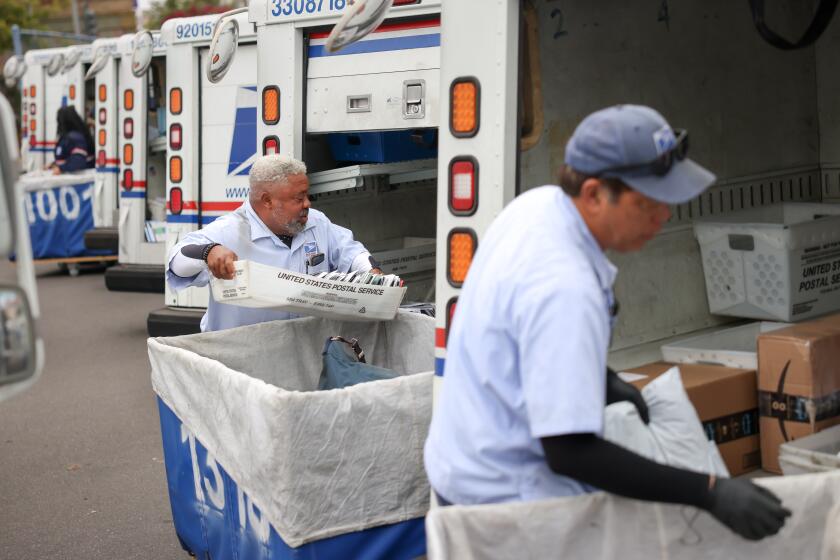Debate on Refinery Acid Report Delayed by AQMD Officials : Safety: Critics say the overly pessimistic report is stacked against using hydrofluoric acid and favors sulfuric acid.
- Share via
Heated criticism by fire and oil refinery officials of a report on dangers of a hydrofluoric acid spill has led air quality officials to postpone consideration of banning the acutely hazardous substance.
The South Coast Air Quality Management District board had been set to debate the matter March 2, but AQMD Deputy Director Ed Camarena told a meeting Friday that additional time is required to respond to criticism from members of an AQMD task force.
The report was attacked by refinery users of hydrofluoric acid as being stacked against the substance and in favor of the less volatile sulfuric acid.
Other critiques faulted the report for using overly pessimistic accident scenarios, for making unrealistic assumptions about the rate at which acid might leak and for failing to take into account the peculiarities of each installation using hydrofluoric acid.
The report was praised, however, by Fred Millar of the Environmental Policy Institute in Washington. His warnings about hydrofluoric acid leaks two years ago helped prompt the AQMD to set up the task force.
Both hydrofluoric and sulfuric acids are hazardous chemicals that can be used by refineries as a catalyst to combine petroleum gases in making a high-octane unleaded gasoline.
In Los Angeles County, four refineries use hydrofluoric acid: Mobil Oil in Torrance, Ultramar in Wilmington, and the Powerine and Golden West refineries, both in Santa Fe Springs. In addition, an Allied-Signal plant in El Segundo uses hydrofluoric acid to manufacture refrigerants.
The Jan. 24 report by the staff of the South Coast Air Quality Management District used computer models to compare a major release of hydrofluoric acid with a similar release of sulfuric acid.
The report based its scenarios on a major release of hydrofluoric acid in 1987 at a Marathon Oil refinery in Texas City, Tex., in which a crane dropped a 30-ton piece of equipment on a 3 1/2-inch pipe connected to a tank filled with the substance. Within 100 minutes, approximately 7,000 gallons were released, according to the report. About 912 people were examined at hospitals; 39 were treated and released, and 97 were hospitalized.
Examining similar releases from storage tanks at each of the four refineries, the AQMD staff report said that hydrofluoric acid, which turns to hydrogen fluoride gas at room temperature, would endanger the public far more than a comparable release of sulfuric acid, which would remain a liquid and not turn into a gas unless heated to 518 degrees.
At the AQMD task force meeting, Marshall (Bud) Bell, refinery manager of Ultramar, said that the release modeled in the report is overly pessimistic.
“I see this as an incredible scenario,” he said. “It is stacked in the wrong direction.”
Bell, whose refinery has just completed a $500,000 risk study for hydrofluoric acid, said that the AQMD staff had made a major mistake by failing to estimate the likelihood of the scenario that the report modeled.
The Ultramar risk study says that the most probable type of release--from a pump joint--is likely to pose an immediate danger to life and health only once every 200 years, and that probability could be greatly reduced by modifying the pumps.
Greg Munakata, a Mobil official, said he doubted that the Marathon accident had released acid at a rate as high as the AQMD study stated.
Chief Richard Anderson, of the Los Angeles Fire Department, said that release scenarios should have been tailored to each installation. He added that a rupture of 3 1/2 inches is unrealistic for a Santa Fe Springs refinery in particular, because the pipes connected to its storage tank are all under two inches in diameter.
Bob Wilson, chief of the Santa Fe Springs Fire Department, said he was concerned that conversion to sulfuric acid would increase the number of trucks carrying sulfuric acid in his city.
The task force is made up of 45 representatives of industry, public safety agencies, other governmental bodies, labor and the public.
Although none of the task force officials at the meeting said they agreed with the report, Millar said in a telephone interview from Washington that the modeling study used conservative assumptions. He added that it conclusions supported his contention that hydrofluoric acid should be banned in favor of sulfuric acid.
Camarena said that the staff would make a status report to the AQMD board at the March 2 meeting.
Refineries in Los Angeles County that use sulfuric acid are the Arco and Shell refineries in Carson, the Texaco and Unocal refineries in Wilmington and the Chevron refinery in El Segundo.
More to Read
Sign up for Essential California
The most important California stories and recommendations in your inbox every morning.
You may occasionally receive promotional content from the Los Angeles Times.










